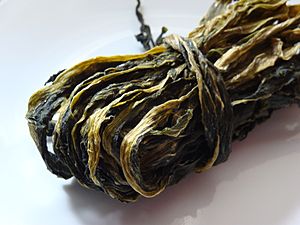Meigan cai facts for kids
Quick facts for kids Meigan cai |
|||||||||||||||||
|---|---|---|---|---|---|---|---|---|---|---|---|---|---|---|---|---|---|

A bundle of meigan cai
|
|||||||||||||||||
| Meigan cai | |||||||||||||||||
| Traditional Chinese | 梅乾菜 | ||||||||||||||||
| Simplified Chinese | 梅干菜 | ||||||||||||||||
| Literal meaning | plum dried vegetable | ||||||||||||||||
|
|||||||||||||||||
| Meicai | |||||||||||||||||
| Chinese | 梅菜 | ||||||||||||||||
| Literal meaning | plum vegetable | ||||||||||||||||
|
|||||||||||||||||
| Second alternative Chinese name | |||||||||||||||||
| Chinese | 霉菜 | ||||||||||||||||
| Literal meaning | moldy vegetable | ||||||||||||||||
|
|||||||||||||||||
Meigan cai, also known as mei cai, is a special kind of pickled vegetable from China. It comes from the Hakka people in Huizhou, Guangdong province. People in Shaoxing, Zhejiang province, also use it a lot in their cooking.
What is Meigan Cai?
Meigan cai is made from different types of Chinese mustard and Chinese cabbage. These vegetables are carefully prepared to become a tasty, dry pickle. It adds a unique flavor to many Chinese dishes.
How is it Made?
Making meigan cai is a long process with several steps. First, the vegetables are picked and trimmed before the Qingming Festival. Then, they are left in the sun until they become soft.
Next, the vegetables are salted or soaked in salty water. They are kneaded to release their juices. After this, they are placed in large clay pots to ferment for about 15 to 20 days.
Finally, the vegetables are steamed and dried many times. This process gives them a reddish-brown color and a wonderful smell.
How is it Used?
Meigan cai is often used to flavor stewed dishes. A very famous Hakka dish is Meigan cai cooked with pork. In this recipe, slices of pork belly are partly cooked and fried. Then, they are steamed with the meigan cai. This makes the pork very tender and full of flavor.
You can also find meigan cai stuffed inside steamed buns. These are called meigan cai baozi. They make a delicious and filling snack.
Meigan cai was once so special that it was given as a tribute to the emperor. This happened during the Qing dynasty.

